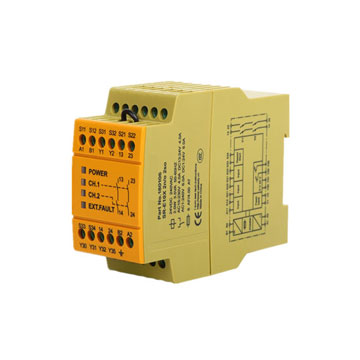Safety Relay Troubleshooting
During the use of a safety relay, it often suffers various faults for many causes, such as poor product quality, improper use, poor maintenance. As only limited types of safety relay are used on vehicles, their faults and treatment, inspection and test are unique. This pasage is mainly introduces troubleshooting with safety relays.
Contact Fault
Due to mechanical occlude (acicular protruding formed on the contact occludes with the pit), fusion welding or cold welding, the contacts can't be separated. As the contact resistance increases and becomes unstable, the circuit can't be connected properly. Due to large load or small contact capacity, or load property change, the contact can't connect or disconnect the circuit. Due to high voltage or clearance between open contacts reduces, the clearance is broken down. Due to high power frequency or large capacitance at the contact gap, the contact can't connect or disconnect the circuit accurately.
Failure of contact work due to various environmental conditions that do not meet the requirements. Contact worn or unnecessary interference caused by no extinguishing devices or measures, or improper parameter selection.
Due to the changes in ambient temperature (exceed the rated value of technical conditions), the coil temperature raises beyond the rated value, thus damaging the coil insulation. Humidity could seriously reduce the coil insulation. Corrosion would also lead to internal breakage or turn-to-turn short circuit. Coil voltage exceeds 110% of the rated voltage, thus damaging the coil.
In application or maintenance, tool collision may also damage the coil insulation or break the coil. As the coil is connected to a wrong voltage, for example, the coil with a rated voltage of 110V is connected to a 220V power supply, or an AC voltage coil is connected to a same grade DC voltage coil, the coil burns out immediately.
AC coil may be burned out because the coil voltage exceeds 110% of rated voltage, or the coil is frequently operated, or the armature can't actuate when the voltage is lower than 85% of rated voltage. When the AC coil is powered on, the armature may not actuate due to transmission mechanism faults, thus burning the coil.
Other Faults
For example, deformation or loosening of several parts, mechanical failure, coating cracks or falls, insufficient insulation between charged parts and the shell; The reaction spring loses elasticity due to fatigue; Setting values are improperly adjusted; The product has reached its specified life.
Many reasons lead to the failure of safety relay. In addition to requiring manufactures to ensure product quality, proper use and careful maintenance are also important factors to reduce failures and ensure reliable work.
Solution
Safety Relay is the main component of electric locomotive control circuit and monitoring protection system. When the electrical components or connection wires in the main circuit or auxiliary circuit break as the electric locomotive is running, the safety relay of corresponding monitoring protection system can transfer the fault into electric signal. On one hand, the electric signal will be fed back to the opening coil of main breaker to trip the main breaker, thus cutting off general power supply of the electric locomotive to protect it. On the other hand, the electric signal will be fed back to signal device (including mechanical signal and electrical signal) and make it to display different fault conditions, thus guiding the electric locomotive conductor to deal with faults timely and correctly. In this respect, the safety relay doesn't directly control the main circuit or auxiliary circuit, but it's of great importance to the electric locomotive.
Moving parts of the safety relay should move flexibly and reliably, the housing and shell should not be damaged or lack of parts. The safety relay should be in a good insulation condition, wear parts and quick-wear parts (including bakelite parts, outer cover, divided magnetic ring, non magnetic gaskets) should be replaced timely in case of damaged, all connection parts should keep a good fastening state.
Measure technical parameters of the safety relay, such as contact thickness, open clearance, overrun and end pressure, all parameters shall meet the requirements of relevant regulations and working documents. Adjust setting values of operation parameters of the safety relay, fix them with stop-off lacquer. In case of special requirements, return coefficient of the safety relay shall also be measured.

